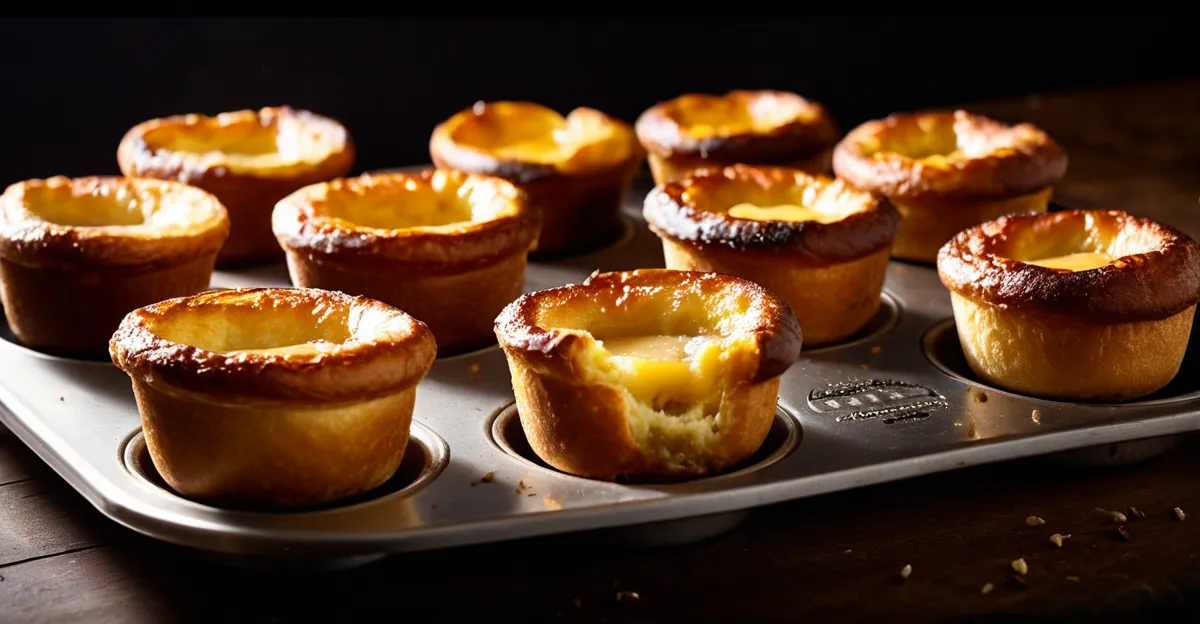The Secrets to Perfect Yorkshire Puddings: A Comprehensive Guide
Understanding the Basics of Yorkshire Puddings
Yorkshire puddings are a staple of British cuisine, particularly when served as part of a traditional roast dinner. These light, airy, and deliciously crispy treats have been a favorite for centuries, but achieving the perfect Yorkshire pudding can be a challenge even for the most experienced cooks. To start, let’s break down what makes a Yorkshire pudding truly special.
The Role of Ingredients
The ingredients for Yorkshire puddings are simple yet crucial. Here’s a basic recipe to get you started:
Also read : What are the must-try recipes for a classic Cornish pasty?
- Flour: Use all-purpose flour or bread flour for the best results.
- Milk: Whole milk is preferred, but you can use any type of milk.
- Eggs: Fresh eggs are essential.
- Salt: A pinch of salt enhances the flavor.
- Fat: Traditionally, beef dripping is used, but vegetable oil or olive oil work well too.
Here’s a detailed list of what you’ll need:
- 1 cup all-purpose flour
- 2 eggs
- 1 cup whole milk
- 1/2 teaspoon salt
- 2 tablespoons beef dripping or vegetable oil
The Importance of Resting the Batter
One of the most critical steps in making perfect Yorkshire puddings is allowing the batter to rest. This step is often overlooked, but it’s vital for the development of the gluten in the flour, which helps the puddings rise.
Topic to read : How Can UK Cooking Techniques Enhance Global Cuisines?
## Why Resting the Batter Matters
- **Gluten Development:** Resting the batter allows the gluten in the flour to relax, making the batter easier to pour and ensuring the puddings rise evenly.
- **Even Mixing:** Resting time helps the ingredients to meld together more evenly, reducing the risk of lumps in the batter.
- **Better Texture:** A rested batter results in a lighter, more tender Yorkshire pudding.
Preparing the Pudding Batter
Preparing the batter is a straightforward process, but it requires some care to ensure everything is mixed correctly.
Mixing the Batter
To mix the batter, combine the flour, eggs, milk, and salt in a large bowl. Whisk the mixture until it is smooth and free of lumps. Here’s a step-by-step guide:
- In a large bowl, whisk together the flour and salt.
- In a separate bowl, whisk together the eggs and milk.
- Gradually add the egg mixture to the flour mixture, whisking continuously until smooth.
- Let the batter rest at room temperature for at least 30 minutes to an hour.
Cooking the Yorkshire Puddings
The cooking process is where many people go wrong. Here are some tips to ensure your Yorkshire puddings turn out perfectly.
Heating the Oven and Tin
Preheating the oven and the pudding tin is crucial. Here’s how to do it right:
- Preheat your oven to 425°F (220°C).
- Place the pudding tin in the oven to heat up. If using a muffin tin, you can use 12 cups.
- Add a small amount of fat (beef dripping or vegetable oil) to each cup. For a traditional large Yorkshire pudding, use a 12-inch tin and about 2 tablespoons of fat.
Pouring the Batter
Once the tin is hot, it’s time to pour in the batter. Here are some key points to remember:
- Hot Tin: Make sure the tin is hot before pouring in the batter. This helps the puddings rise immediately.
- Pour Quickly: Pour the batter into the hot tin quickly to prevent the fat from cooling down.
- Do Not Open the Oven Door: Resist the temptation to check on the puddings during the first 20 minutes. Opening the oven door can cause them to collapse.
Here’s an example of how to pour the batter:
## Pouring the Batter
- Remove the hot tin from the oven and carefully place it on a heat-resistant surface.
- Pour the rested batter into the hot tin, filling each cup about 2/3 full.
- Return the tin to the oven immediately.
Cooking Times and Tips
Cooking times can vary depending on whether you are making individual Yorkshire puddings or a large one.
Cooking Individual Puddings
For individual puddings in a muffin tin:
- Cook for 20-25 minutes. The puddings should be puffed and golden brown.
- Check after 20 minutes; if they need more time, cook for an additional 2-5 minutes.
Cooking a Large Pudding
For a large Yorkshire pudding in a 12-inch tin:
- Cook for 40-45 minutes. The pudding should be puffed and golden brown.
- Check after 40 minutes; if it needs more time, cook for an additional 5 minutes.
Here are some additional tips to keep in mind:
## Cooking Tips
- **Use the Right Fat:** Beef dripping gives the best flavor, but vegetable oil or olive oil work well too.
- **Do Not Overfill:** Fill the tin cups about 2/3 full to allow room for the puddings to rise.
- **Keep the Oven Hot:** Ensure the oven remains at the correct temperature throughout the cooking time.
Serving Your Perfect Yorkshire Puddings
Yorkshire puddings are traditionally served as part of a roast dinner, alongside roast beef, vegetables, and gravy.
Pairing with Roast Beef
Roast beef and Yorkshire puddings are a classic combination. Here’s why they pair so well:
- Contrasting Textures: The crispy outside and fluffy inside of the Yorkshire pudding complement the tender roast beef perfectly.
- Flavor Enhancement: The savory flavor of the roast beef is enhanced by the light, slightly sweet taste of the Yorkshire pudding.
Adding Gravy and Vegetables
To complete the meal, add some delicious gravy and a variety of roasted vegetables.
## Completing the Roast Dinner
- **Gravy:** Use the juices from the roast beef to make a rich, flavorful gravy.
- **Vegetables:** Roasted vegetables such as carrots, Brussels sprouts, and potatoes add color and flavor to the dish.
Common Mistakes and Solutions
Even with the best recipe and techniques, things can go wrong. Here are some common mistakes and how to avoid them:
Mistake: Puddings Not Rising
- Solution: Ensure the oven and tin are hot enough before pouring in the batter. Also, make sure the batter has rested long enough.
Mistake: Puddings Collapsing
- Solution: Avoid opening the oven door during the first 20 minutes of cooking. This allows the puddings to set properly.
Mistake: Puddings Too Greasy
- Solution: Use the right amount of fat and ensure it is hot before adding the batter.
Here’s a table summarizing some common mistakes and their solutions:
| Mistake | Solution |
|---|---|
| Puddings not rising | Ensure oven and tin are hot; rest batter long enough |
| Puddings collapsing | Avoid opening oven door during first 20 minutes |
| Puddings too greasy | Use right amount of fat; ensure fat is hot before adding batter |
| Puddings not golden brown | Check oven temperature; ensure tin is hot before adding batter |
Quotes from Experts
Here are some insights from culinary experts on making perfect Yorkshire puddings:
- “The key to perfect Yorkshire puddings is in the resting of the batter. It allows the gluten to relax, making the batter easier to pour and ensuring the puddings rise evenly.” – Jamie Oliver
- “Using the right type of fat is crucial. Beef dripping gives the best flavor, but if you’re looking for a healthier option, vegetable oil works well too.” – Gordon Ramsay
- “Don’t overfill the tin cups. You want to leave enough room for the puddings to rise and get that beautiful, puffed texture.” – Nigella Lawson
Practical Insights and Actionable Advice
Here are some practical tips to help you make perfect Yorkshire puddings every time:
Use Room Temperature Ingredients
- Ensure all your ingredients, including the eggs and milk, are at room temperature before mixing. This helps the batter mix more smoothly and evenly.
Choose the Right Tin
- Use a tin that is specifically designed for Yorkshire puddings. A muffin tin works well for individual puddings, while a 12-inch tin is ideal for a large Yorkshire pudding.
Don’t Overmix
- Mix the batter just until the ingredients are combined. Overmixing can result in dense, flat puddings.
Here’s a detailed bullet point list of practical insights:
- Use room temperature ingredients to ensure smooth mixing.
- Choose the right tin to help the puddings cook evenly.
- Don’t overmix the batter to avoid dense puddings.
- Let the batter rest to allow gluten to relax and ensure even rising.
- Preheat the oven and tin to the correct temperature before cooking.
- Use the right amount of fat and ensure it is hot before adding the batter.
- Avoid opening the oven door during the first 20 minutes of cooking.
By following these tips and avoiding common mistakes, you’ll be well on your way to making perfect Yorkshire puddings that will impress your family and friends. Whether you’re serving them as part of a traditional roast dinner or as a side dish, these secrets will help you achieve the light, airy, and deliciously crispy Yorkshire puddings that everyone loves.






